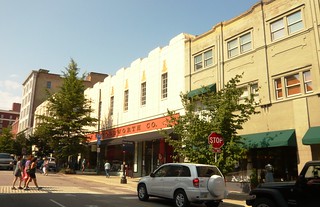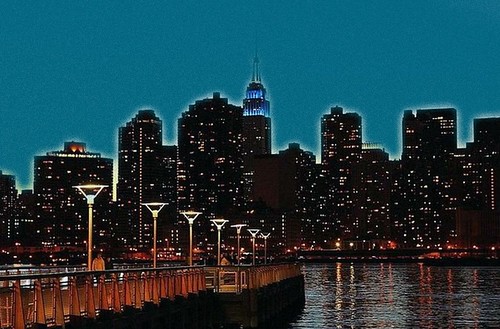Cities and the ecology of "people habitat"

Posted March 27, 2013 at 1:24PM
I am very pleased to announce that my new book, People Habitat, will be coming out in January 2014. It will be available in both print and ebook formats, and it will cover 25 ways - most presented through examples or personal experiences - to think about greener cities. Readers of my articles will find subjects both familiar and new.
This post is the first of a number of excerpts I expect to publish here before the full volume comes out. It’s from the introduction:
As children, we spend a lot of time imagining things we haven’t experienced yet, and imagining unknown aspects even of things we have already begun to experience. That’s the way it was for me as a kid and, really, that’s the journey I continue to this day. More about that in a few paragraphs.
This will be the fourth book about some aspect of cities and the environment with my name on the cover. As I begin, I am increasingly excited about it: I am expecting this to be the one truest to my heart and most fun to write. I am proud of the others, of course, which each pursued an important topic in depth, and explored points of advocacy on behalf of my employers. But this one comes from me alone. I intend it to go broad, presenting a wide range of essays united only by my hope that readers will think with me about how to make human settlement as good as possible.
That may sound a bit glib, but I want to probe some of the more difficult topics, the ones where the answers aren’t so clear. The subjects of this book are intriguing to me precisely because they aren't always straightforward, and I hope they will be intriguing to you.
I owe the title People Habitat to my friend Trisha White, an expert on the interactions between the built environment and wildlife. Trisha believes many wildlife species do best when nature’s critters have a realm or habitat that is primarily their own, and when we humans have the same, a “people habitat” that can be distinguished from places where wildlife is primary and we are secondary. It seemed a catchy phrase and an intriguing idea. I first heard Trisha use it at a meeting and never forgot.
To me, "people habitat,” which borrows a word often associated with the field of natural ecology, evokes a different sort of ecology, one centered around humans. There are similarities between the two types, including the key point that ecology is about relationships and interactions among different aspects of a single system. The system works best when those relationships are in balance, and that leads me to a guiding principle: as with the natural environment when operating at its best, the environment built by humans should achieve harmony among its various parts and with the larger world upon which it depends.
Spatially, we can think of habitat for a species of wildlife as a realm that starts in a nest or den and extends outward from there. In my mind, so does people habitat: our domain begins in our homes but also extends outward, to our neighborhoods, our cities or towns, and even to the regions beyond.
For most of us, our experience of the human environment – our people habitat – begins as children, discovering the things around us, including cities. For me, as a kid living with working-class parents in a small, sleepy southern city, I mostly imagined – rather than experienced – larger cities of consequence. Except for a couple of short but memorable trips as a preteen, I didn't experience "real" cities until I went off to college in Atlanta. I was in my late 30s before I could afford to visit international cities.
I am quite sure I did not even know there was such a thing as urban planning until almost as late. My parents had tons of smarts and great instincts, but no higher education, and I was pretty much on my own for finding my way into college, then law school, and eventually a profession. I made it up as I went along. Still am, really.
 My hometown of Asheville, North Carolina had a smallish downtown, and instinctively that’s where I wanted to be on a Saturday when I was growing up. Sometimes I would hop on the city bus, take myself down there, and hang out, with no set agenda. I loved the city library, the tiny downtown park, the main square, the Woolworth’s, the movies, the music store. Especially the library and music store. Downtown, sleepy though it was, seemed like a place where things happened, where grownups more important than me did . . . what, exactly? That wasn't yet of interest.
My hometown of Asheville, North Carolina had a smallish downtown, and instinctively that’s where I wanted to be on a Saturday when I was growing up. Sometimes I would hop on the city bus, take myself down there, and hang out, with no set agenda. I loved the city library, the tiny downtown park, the main square, the Woolworth’s, the movies, the music store. Especially the library and music store. Downtown, sleepy though it was, seemed like a place where things happened, where grownups more important than me did . . . what, exactly? That wasn't yet of interest.
In my own way, I had stumbled upon some of the amenities that even small-city downtowns, if they are good ones, can provide: animation; a lot of optional activities close at hand; the possibility of a chance encounter with a friend or interesting stranger. Asheville also had, and still has, lovely residential neighborhoods – many with spectacular views, because the city contains actual (if small) mountains within its borders. But they were places where I went to see friends or attend planned events; I didn’t go just to go, as I did with respect to downtown.
My forays into our city center notwithstanding, truly impressive cities were places I only saw on TV, or occasionally heard about from distant relatives who, for reasons still not clear to me, actually lived in Manhattan. In my mind, New York was very tall, exotic buildings and lots of stores and bright lights. A subway! Los Angeles was Disneyland, the beach, cool-looking freeways, and Hollywood. Cleveland was a place with a baseball team whose games one could listen to late at night when the clear-channel radio stations came in.
But I always had a sense that the cities of my imagination were my true home, where I would feel most comfortable on an everyday basis. The great American writer Thomas Wolfe, an Asheville native, memorably wrote, “You can’t go home again.” And, indeed you can’t, especially if the meaning of “home” is accompanied by visions conjured as much as experienced. But that hasn’t kept me from trying.
I suppose that, all along the way, I’ve been picking up bits of information and clues about what makes cities great, what makes the human ecology work especially well. I’ve never had any formal training in that, and didn’t really have any professional connection to these issues, either, until late in my career. I’m basically a self-taught urbanist.
I’m still making my own way, just as I did as a kid in the South over four decades ago. I didn’t so much learn from my forebears and childhood urban experiences, but from my curiosity, and from a sense that life could be better. That’s now the quest that a whole bunch of city-minded people I am honored to call friends and fellow urban travelers are on.
This book will be an attempt to share 25 observations picked up along the way, plus some discussion of particular places that illustrate or enlarge the observations. It was difficult to choose 25, but the choices were not arbitrary. By intention, these ideas are not all in line with prevailing environmental and urbanist thinking, not all fully formed and, truth be told, not even all consistent with each other. I believe that’s as it should be. Ecology is a complicated science, and we live in a world of questions as much as answers. Anyone who pretends to have all the answers is faking it, in my humble opinion.
If my journey began with my imagination, I hope my thoughts will stimulate yours. To me these 25 notions include important ones, challenging ones, and a couple that are just fun. They can be read in any order you like. They are the thoughts I most wanted to share, and I hope you enjoy reading them as much as I enjoyed writing them.
Speaking of imagination, here’s a very special treat for you. The dated video is grainy, but the music is spectacular:
My previous books about cities include Once There Were Greenfields (NRDC, 1999); Solving Sprawl (Island Press, 2001); Smart Growth in a Changing World (Planners Press, 2007); and several others to which I have contributed chapters. I also co-wrote Reaping the Revenue Code (NRDC, 1986), about agricultural taxation and quite the page-turner.
Related posts:
- How I'm thinking about people habitat these days (July 23, 2012)
- People Habitat: great city places (November 7, 2011)
Move your cursor over the images for credit information.
